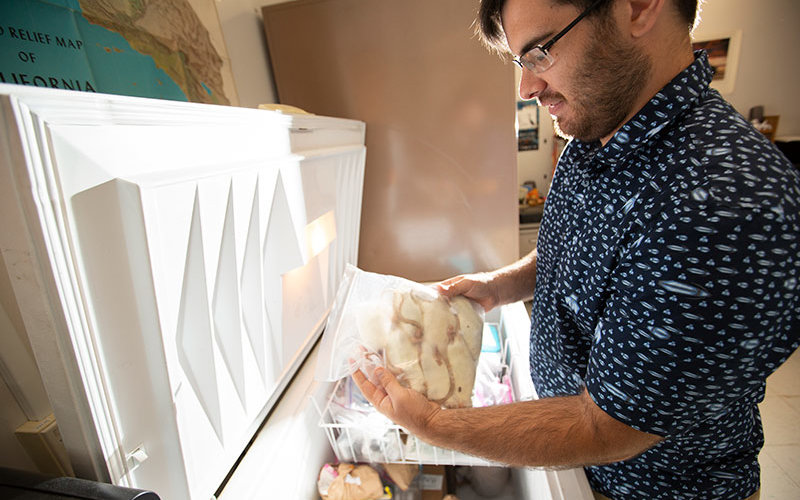
In Southern California, rat poison has been blamed for the deaths of large carnivores such as coyotes, foxes, bobcats and mountain lions. It’s a mystery how these native predators are ingesting lethal rodenticides intended to control roof rats and house mice — non-native species that are major pests in homes, yards, garages and restaurants.
“Not a lot is known about how these large predators are being exposed, so to figure out how to eliminate this problem, it is first important to understand what animals are visiting commercial bait boxes that contain these poisons,” said biology graduate student Chris Burke. “Once that information is known, it will be easier to narrow down which of these animals the larger carnivores are eating to ingest these poisons.”
Under the mentorship of Paul Stapp, professor of biological science, and in collaboration with scientist Niamh Quinn, a human-wildlife interactions advisor with the University of California Cooperative Extension in Irvine, Burke is studying how native wildlife is exposed to rodenticides. Burke has been working on the research over the past two years for his thesis project.
“To date, there’s been little evidence that these mammalian carnivores eat many non-native rats and mice species,” Stapp said. “Our work is aimed at identifying the pathways of exposure to rodenticides for native wildlife. These results that could lead to better and safer uses of rodenticides by landowners and pest control operators — and identify situations in which other methods besides rodenticides should be used.”
For his project, Burke set up bait stations — tamper-proof black boxes — at 90 sites in Orange County — in the backyards of homeowners who participate in the Master Gardeners of Orange County program, and grow large amounts of fruits and vegetables, which attract animals, including rats.
Burke used non-poisonous baits — with scents such as peanut butter that would not harm any animals — in the boxes to observe which animals were attracted to the bait stations. He set up cameras to actually view what non-native and native species use the bait stations. He found high levels of animal visitation to the bait stations, especially by non-native roof rats, with native species, such as opossums and raccoons, also trying to enter the bait stations or chew through the hard plastic boxes.
“In the yards with cameras, it’s clear that non-native roof rats are by far the most common species visiting the bait stations. Roof rats are present in 80% of them,” Burke said, followed by non-native fox squirrels and feral cats.
Although smaller predators also are drawn to the bait boxes, larger carnivores like bobcats and coyotes tend to be extremely rare in yards, with a presence of less than 10%,Burke said. Additionally, bait stations that are placed off the ground in trees or along walls had fewer animal visits, except by roof rats, than those placed on the ground.
“It also turns out that native rodents appear almost exclusively at yards that are near natural areas such as parks or open spaces, which is very important because it gives us an idea when and where rodenticides used to control rats could pose a significant threat to native species,” Burke said.
Burke plans to finalize his thesis research early next year and publish the results in a scientific journal. He also is creating a guide for pest management professionals about the best use of rodenticides with the least risks to native wildlife.
With plans to pursue a career as a wildlife biologist, Burke became interested in the rodenticide research because of the unintentional poisoning of local wildlife, which has stirred public debate. In 2014, the sale and use of some rodenticides were banned in California, except to licensed commercial exterminators. Earlier this year, the state Assembly passed a bill to ban dangerous and lethal pesticides, but late this summer, the billed failed in the state Senate.
“It’s good to know that the research that I am doing at Cal State Fullerton could have a big impact on future policy as well,” Burke said.